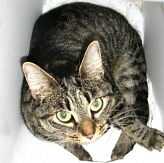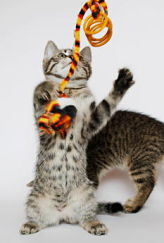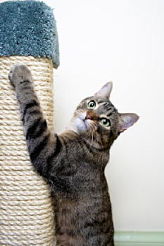Multi-CatHouseholds
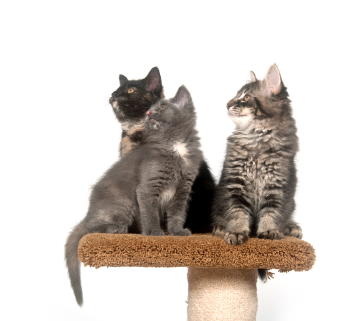
Multi-cathouseholds belong to those of us that have taken in a few needy felines over the years and now are part of the multi-cathouseholds group, meaning... you are surely not alone. After the passing of my older cats a decision was made to adopt 2 kittens from the local shelter. They are now 12 years old.
Then Max arrived at the door in the next year looking pathetic and he is now 11 years old. Max was the only one allowed outside for brief ventures, then brought home a teeny 6 month old Coty who is now 7 years old, and a year later he brought home our 6 month old Chanel#5 who is now 5 years old. Then Giorgio, a neglected neighbor's cat of 3 years old joined us and we became the multi-cathouseholds of 6.
Multi-cathouseholds pose special challenges. Not only in terms of feeding, cleanup, and veterinary care, but also in the area of "keeping the peace". Cats in groups don't always get along. Territorial creatures that they are, cats sometimes seek to exclude other cats by fighting or marking range boundaries with urine or scratch marks.
While these behaviors are natural in the wild, they are simply not acceptable in the house. However, you have a good chance of deterring domestic disputes if you consider your cats' social needs.
We have partially solved this situation by keeping Revlon and Blaze on the upper floor with their own food, water and litter box along with their own small outside terrace. The other 3 are on the main level with the larger terrace, food, water, and a litter box. These 3 are not allowed upstairs and after training with Invisible Fence we were able to achieve this.
Revlon and Blaze are allowed downstairs because the whole house was their territory prior to letting in the 3 strays, but they only pass through once or twice a day snooping. Giorgio is still an outdoor critter for most of the day and he sleeps in a basement guestroom because, unfortunately, he and Max have issues and he's too lively for the others.
Cats in the wild are usually solitary creatures. They travel alone, hunt alone, and only associate with other adult cats for mating. But if food is plentiful in one particular area...such as the dumpster in Spain mentioned on the Cat Colonies page, then the cats will congregate in groups to get the food. Cat colonies lack the well-defined rank hierarchy of dog packs.
However, cats have the ability to adapt and have a repertoire of signals such as body postures, ear and tail positions, and facial expressions to convey their intent.
Signals also allow cats to form close ties. Some cats spend more time together and even snuggle up together for naps and grooming. Revlon and Blaze were like this when they were younger but now although they occasionally groom each other, they have their own beds.
Coty and Chanel have gotten closer now that Chanel isn't so small and they both treat Max like he's their father because he's the one that found them a home. We've told Max that there are no more vacancies and he hasn't brought home any more kittens.
Cats living together in multi-cathouseholds form social bonds and use signals just like animals in feral cat colonies, but in-house groups have some important differences. They have less space, they usually do not have the close genetic ties (only my Revlon and Blaze do), and they don't have the option of leaving if they are unhappy as they would do if they were in a feral cat colony.
In some multi-cathouseholds, intercat aggression can escalate to the point where certain cats become social outcasts and the cat may be so cowed by their feline housemates that they won't come out of hiding for meals or the litter box. This was a problem with Chanel when Revlon used to come downstairs and look for her. Revlon doesn't like Chanel and if Coty wasn't around to protect Chanel, Revlon would chase her under the sofa and Chanel wouldn't come out for hours.
Now that Chanel is older, larger and wiser, she is no longer Revlon's target. But if a re-occurrence happens, knowing that cats don't do well with punishment, we still send Revlon upstairs and she's not allowed back down for the rest of the day.
Revlon going after Chanel seems to be the only real conflict that exists that isn't defensive. Coty (our smallest but most athletic cat) will stand between Chanel and Revlon with an aggressive look...and Revlon will back off. We call Coty "our little Napoleon". Max, the largest cat, is just a good, mellowed out oaf. His bad trait is "urine marking" to let the upstairs cats know that the main level is his. I've got that under control most of the time but with a few relapses.
Keeping the Peace
The first step in eliminating the stress of group living in a multi-cathousehold is to make sure all of your cats are neutered. Also, you want to provide "private areas" where a cat can go to "get away from it all". A cardboard box with a hole in it is always popular around our home. The cat tree with separate level perches is a winner.
There is a bathroom window off of our office where there is a cat bed and the 3 downstairs cats take turns watching out that window. They also have the terrace with a blanket on the bar-b-que so they can lounge outside in good weather. The upstairs cats have chairs at windows to look out and they also have their smaller outside terrace.
If you don't have separate levels in your home you can also provide an escape area for a fearful cat to lounge in peace, have quiet moments, etc. by placing a small entry in the door that is coded to only let specific cats enter. Perhaps a spare bathroom can be utilized for this purpose, or a laundry room, etc.
Sure Flap makes several sizes that can be programmed to read your cats microchip. If your cats doesn't have a microchip, then they provide a coded collar tag. Just options to consider if you are having compatibility issues. You can find examples on our Pet Products Page.
Provide several litter boxes. I have seen it recommended that you have one for each cat, but if you are limited with floor space like I am, you can get away with several cats sharing. The two cats upstairs share a litter box and the 3 downstairs share a second litter box. Giorgio has his own in the basement for when he's home.
I scoop them often throughout the day to keep odor down and also to encourage the cats to stay clean. Shelves that cats can jump to are also popular and the two upstairs cats jump onto a dresser that's available while the downstairs cats have several shelves they can reach. Multi-cathouseholds do present challenges.
Separate feeding stations work well. Cats don't usually
compete over food, but Max is a pig and will eat everything in sight so
he has his dish by the bar. He's not a good jumper so Chanel and Coty
have their dishes on top of the bar. They have a community water source
and dry food dispenser easily reached by all 3 of them. Upstairs, the
cats share well and their food dishes are side by side with another dry
food dispenser and water source. Giorgio has his own in his area.
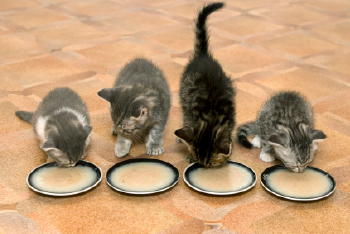
Related Articles......
Return from Multi-CatHouseholds to Cat Health Homepage
Having trouble finding what you need? Cat Health Index & Site Map
OR
Do you have a question to ask?...Questions
OR
Do you have a cat story to share?...Simply click here to go to that page!
Copyright@2010-2020 All rights reserved.Cat-health-detective.com
This website is information only. Consult a veterinarian for medical assistance

"Like Us" on Facebook
or...
"Like Us" here

